Audi Q7: Rear Brake Pads, Removing and Installing
Special tools and workshop equipment required
- Vehicle Diagnostic Tester
- Torque Wrench 1331 5-50Nm -VAG1331-
- Piston Resetting Tool -T10145-
- Lithium Grease -G 052 150 A2-. Refer to the Parts Catalog.
 Caution
Caution
This procedure contains mandatory replaceable parts. Refer to component overview prior to starting procedure.
Mandatory Replacement Parts
- Brake Pad Wear Indicator Wire - Replace when pads are replaced.
- Brake Pad Retaining Plate - Replace when pads are replaced.
- Brake Pad Spring - Replace when pads are replaced.
Removing
- Loosen the parking brake.
- Switch off the ignition.
 Note
Note
- Label the brake pads that will be used again when removing. Install in the same position, otherwise the braking effect will be uneven.
- Do not disconnect the connectors from the parking brake motors.
- Remove the rear wheel. Refer to → Suspension, Wheels, Steering; Rep. Gr.44; Wheels and Tires.
 Note
Note
If the brake pads are replaced, use the Vehicle Diagnostic Tester to press back the parking brake motor.
- Drive back the parking brake motor:
- Connect the Vehicle Diagnostic Tester to the diagnostic connection on the vehicle with the ignition switched off.
- Switch the ignition on.
- Select diagnostic and start.
- Select the Test plan tab.
- Select Individual tests... and select the following tree structures one after the other:
- Suspension
- Brake System
- 01 - OBD-capable systems
- 03 - ABS Control Module J104 integrated parking brake
- 03 - Electric parking brake functions
- 03 - Removing the brake pads
- Start the selected program and follow the instructions in the display of the Vehicle Diagnostic Tester.
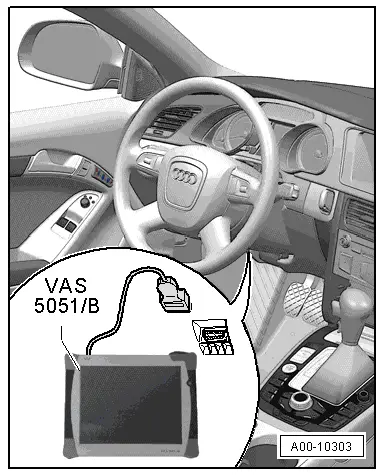
- Free up the wire, to do so open the protective cap -2- from the bleed screw and open the clip -1-.
- Carefully remove the contact -4- for the brake pad wear indicator using pliers at the same time pay attention to the clip -3-.
 Note
Note
If the clips go missing, the brake pad wear indicator wire must be replaced.

- Remove the bolts -arrows- by counterholding the guide pins -1 and 2-.
- Remove the brake caliper and guide the brake pad wear indicator wire out at the same time.
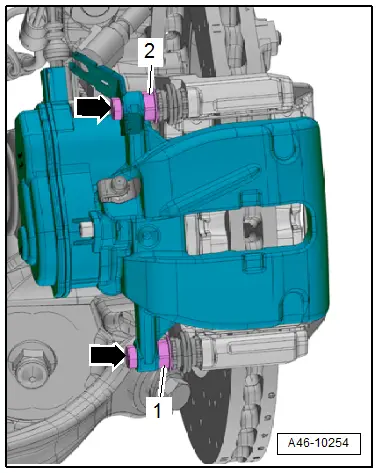
 Caution
Caution
Danger of damaging the brake hose.
- Do not let the brake caliper hang on the brake hose. Do not support the weight with the brake hose.
- Replace the brake hose if damaged.
Risk of damaging the brake caliper piston.
Do not operate the brakes or the electro-mechanical parking brake when the brake caliper is removed.
- Hang the brake caliper using a suitable wire.
- Remove the brake pads.
Installing
Install in reverse order of removal and note the following:
- When the brake pads are replaced, check the brake rotors for wear and damage:
- Brake rotor wear limit. Refer to → Chapter "Technical Data".
 Note
Note
- Always replace brake pads on the same axle at the same time.
- When installing new brake pads use the repair kit and new brake pad wear indicator wire.
- Replace the brake caliper bolts after disassembly.
 WARNING
WARNING
Health Risk.
Do not blow out brake system with compressed air.
 Note
Note
- Use only mineral spirits to clean the brake caliper.
- Check the brake caliper piston protective caps for damage and install the complete repair kit, if necessary. Refer to → Chapter "Brake Caliper Piston, Removing and Installing".
 Caution
Caution
Danger of contamination and paint damage from escaping brake fluid.
- If the brake pads are worn out and unnecessary brake fluid was filled, the brake fluid may overflow, when the brake caliper pistons in the brake cylinders are pressed back.
- Check the brake fluid level before pressing back the brake caliper pistons. If there is brake fluid up to the "MAX" mark, some brake fluid will need to be extracted.
- Use the Brake Charger/Bleeder Unit -VAS5234- to extract brake fluid from brake fluid reservoir.
- Use the Piston Resetting Tool -T10145- to completely press back the brake caliper piston.
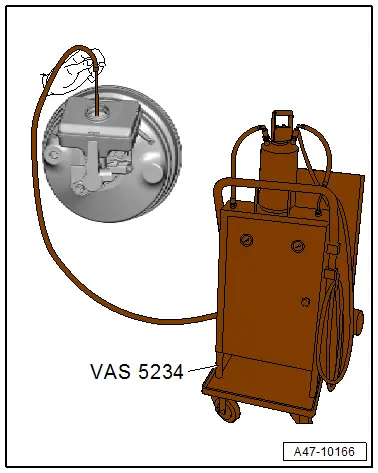
- Clean the brake carrier -1- on the brake pad spring contact surfaces -arrow- and thinly coat them with lithium grease.
- If re-using, install the marked brake pads in the same location.
- Insert brake pads in brake carrier.
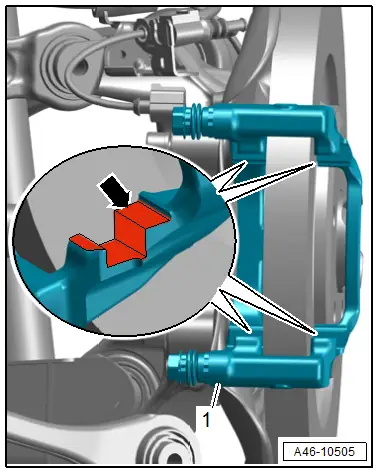
- Push the brake caliper over the installed brake pads.
 Note
Note
- Make sure that the wire and brake hose are routed correctly.
- Make sure the brake hose is not blocked, bent, twisted or rubbing against the vehicle.
- Tighten the new brake caliper bolts -arrows- by counterholding the guide pins -1 and 2-.
 Note
Note
- Check the brake pad wear indicator contact for damage and if required replace.
- Make sure that the brake pad wear indicator contact fits correctly in the brake pad.
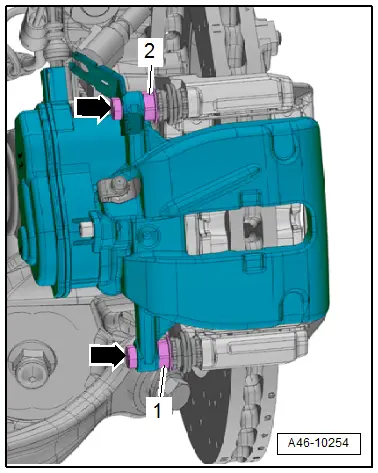
- If the clips go missing, the brake pad wear indicator wire must be replaced.
- Insert the contact -4- for the brake pad wear indicator with the clip -3- until it engages in the inner brake pad.
- Secure the brake pad wear indicator wire with the protective cap -2- and the clip -1-, as shown.
- With the vehicle stationary, firmly press the brake pedal several times so that the brake pads in the operating condition properly set in their respective position.
- Drive the parking brake motor out. Refer to Vehicle Diagnostic Tester by following the instructions in the display.

 WARNING
WARNING
Risk of accident!
- With the vehicle stationary, firmly press the brake pedal several times so that the brake pads in the operating condition properly set in their respective position.
- Make sure the brakes are working correctly before driving the vehicle for the first time.
Tightening Specifications
- Refer to → Chapter "Overview - Rear Brakes"
- Refer to → Suspension, Wheels, Steering; Rep. Gr.44; Wheels and Tires.

